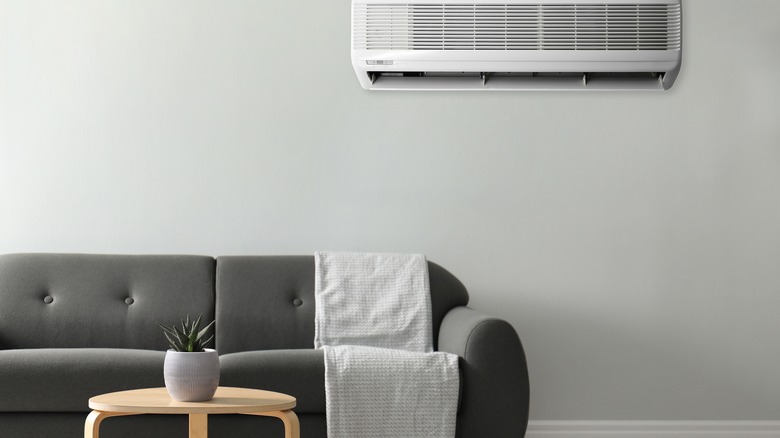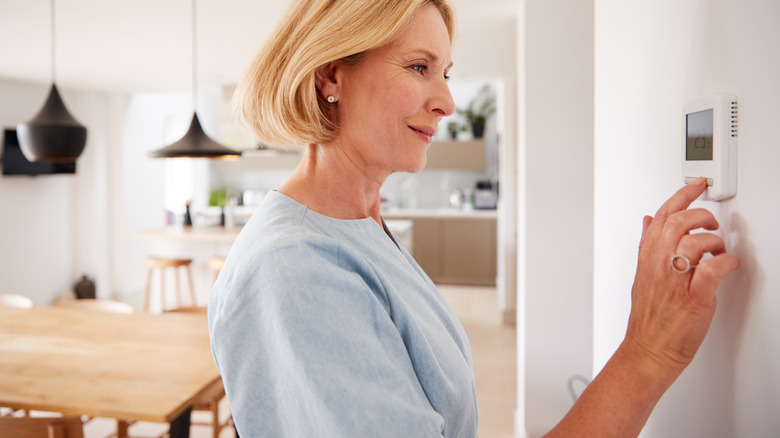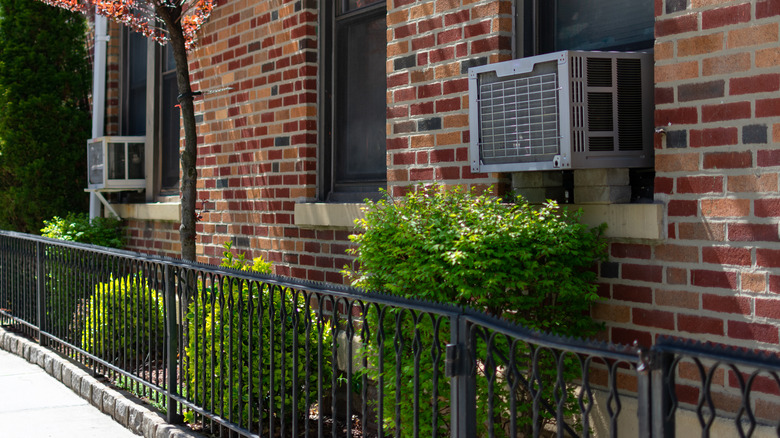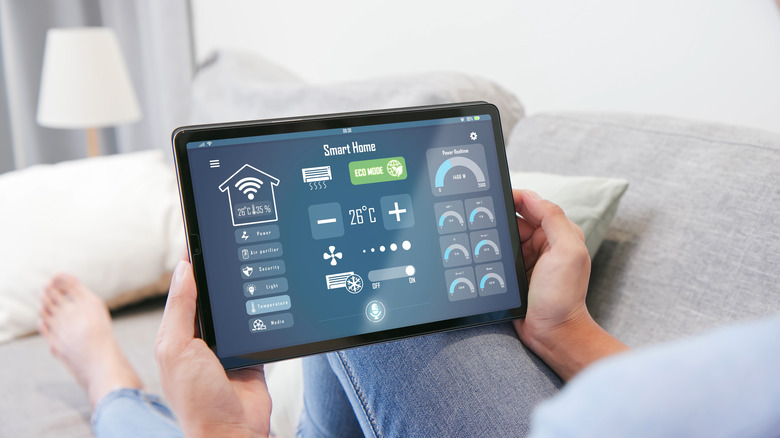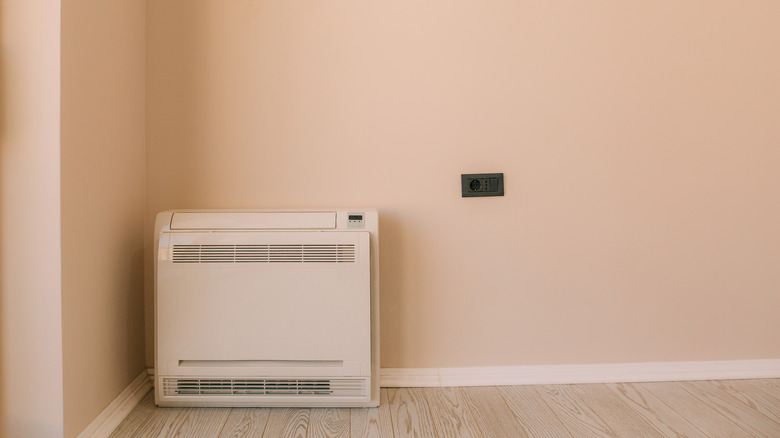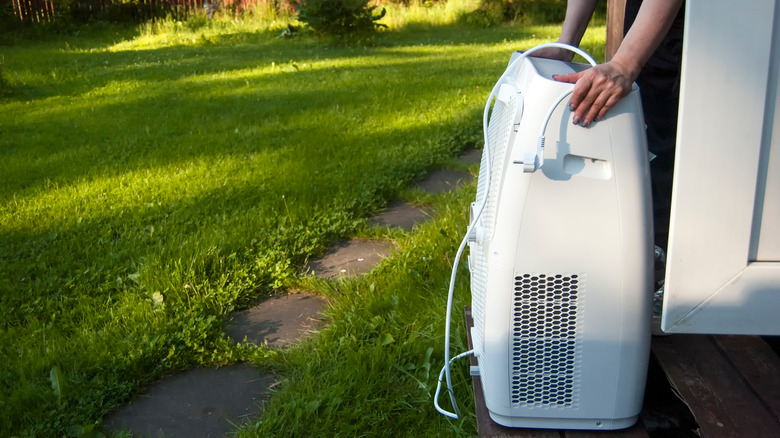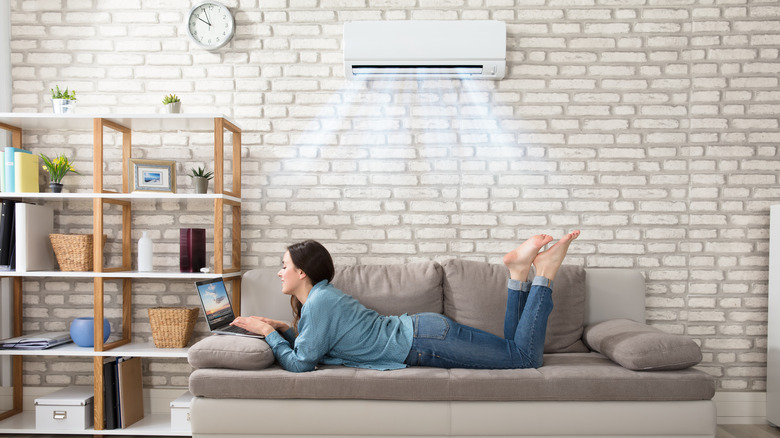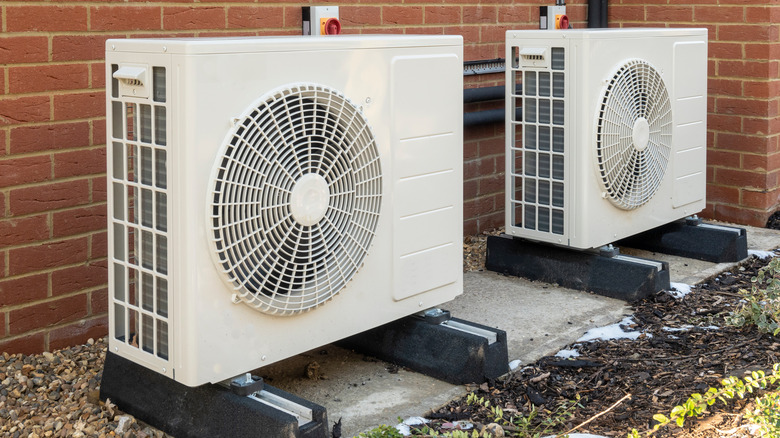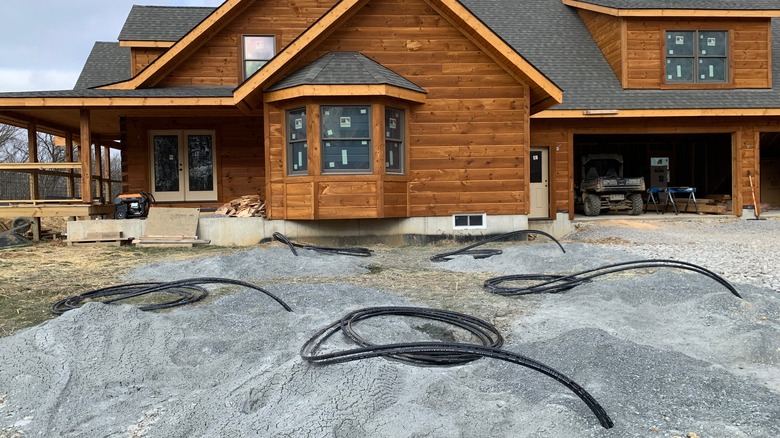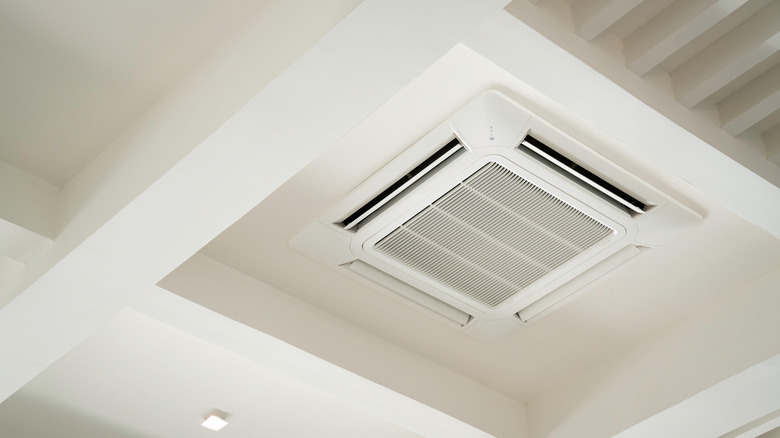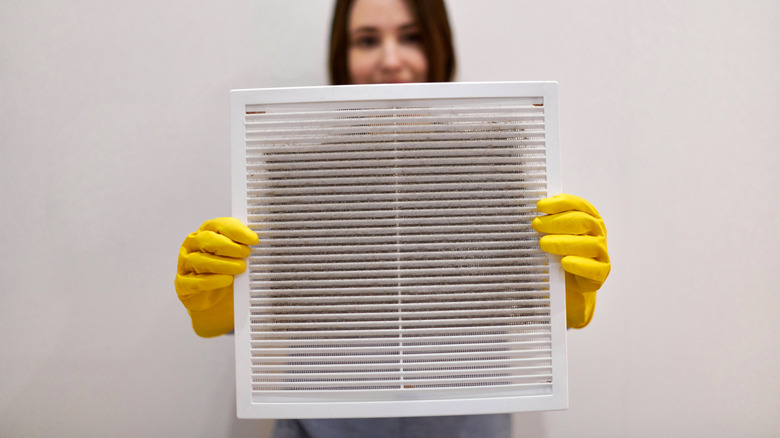The Hidden Downsides To Air Conditioners
In the heat of summer, we're all thankful for air conditioning. No one wants to sweat while working, enjoying a meal, or cleaning the house. Doctor HVAC writes that air conditioning has some health benefits, including lowered humidity, a reduction in asthma attacks, and fewer insect invasions. However, there are hidden downsides to running cold air into our homes. The reduced humidity is helpful in some ways; however, it also leads to dry eyes, dehydrated skin, irritated airways, and headaches (via WebMD).
Air conditioning also lowers your heat tolerance. Have you ever been in a cold building all day and then stepped outside into the heat? The heat seems extra intense because you've been surrounded by cold air for hours. If you were in a room with an open window and no air conditioning, your tolerance would be higher. We are pampered by the A.C. There's nothing wrong with being comfortable in your home or office, but there's no denying that cold air lowers our heat tolerance. In this article, we'll discuss the hidden downsides to air conditioners and the nine types of units most often used for A.C.
A central air conditioning system
Central air conditioning is the most common in homes today. It's also the most expensive to install. According to Service Legends, central air is especially popular for larger homes because of its ability to circulate air throughout an entire building. It requires an installed ductwork system and vents for the air to flow through. That's part of why it's so expensive — the ductwork is hidden in walls and ceilings. If it isn't in place when a home is finished, installing it will require the destruction of walls and ceilings, increasing the price due to the extra work.
In most cases, you're looking at anywhere from $3,800 to $7,500 for a central air installation (via HomeAdvisor). That price gets higher as the house gets larger. There are other factors to consider, such as any ductwork that is or isn't already in place, plus labor costs.
Once installation is done, maintaining a central air system is expensive. Expect your energy bill to skyrocket. The house feels great and evenly cooled in every room, but it takes a lot of energy to make it happen — on average, about 2,000 kilowatt-hours of electricity each year (via Department of Energy). Another downside to central air is the fact that you must maintain the ductwork. To prevent bacteria and mold from growing, it's recommended to have your ducts inspected once a year and cleaned as needed (via National Air Duct Cleaners Association (NADCA)). Central air works well, but if you're hoping to cut energy costs and lower the need for maintenance, it won't be helping you out in those areas.
The window unit
Window air conditioners come in many sizes, which makes them useful for both small and larger areas. You might see a window unit in an older home since many homes were built before the use of central air. Popular Mechanics reports that the first commercial window-unit air conditioner was created in 1931, and the early price tag was $10,000 to $50,000 ... talk about luxury. Thankfully, a window unit is much more reasonably priced today, but unfortunately, they aren't without complications.
Window units sit in a window, so obviously, you have to have an available ledge. While having an appliance take over a whole window for the summer might be annoying, the real downfall behind a window unit is that it's not a reliable way to cool an entire home, as per Salazar Heating and Air. There's no ductwork, meaning there is no way to circulate the cold air from the window unit into multiple rooms. In addition to being limited, it can also create health complications if it isn't cleaned regularly. Specifically, if the filters on a window unit aren't changed regularly, mold and bacteria will grow and be blown around the room.
A smart air conditioner
A smart air conditioner is operated right from your smartphone. That sounds convenient, but it has its downsides. For starters, if you aren't near Wi-Fi, don't count on the operation from your phone to work well. Also, smart air conditioners are expensive and require multiple units to cool an entire home, as per Ideas by Mr. Right. They don't cool from a central location but need a window or wall space, which allows them only to cool a small area. At $300 to thousands of dollars — depending on the size of a unit — the need for multiple units brings the price up and makes installation time-consuming and expensive (via Lifewire).
While some people might enjoy the high-tech ability to control their smart air conditioners from their phone or tablet, others may find that it's just another thing to program and keep track of. This might lead them to think they would be better off with an old-fashioned "set it and forget it" thermostat.
A floor-mounted air conditioner
According to Pioneer, a floor-mounted unit is a ductless system, but it's mounted at the bottom of a wall close to the floor. It has a second outdoor unit, which it's connected to through a refrigerant line installed in the wall. They're convenient for rooms that don't have a lot of height or space, but sadly, they aren't efficient. Because floor-mounted units are close to the ground, they are set up to work against the natural tendency of hot air rising and cool air falling (via Cohesive Homes). As cold air is pumped out, it falls to the ground, while the hot air rises and continues to warm the room. A floor-mounted air conditioner has to work extremely hard to cool the room. Sure, the lower areas will be cool, but unless you intend to lay on the floor all day, it won't be helpful.
Also, air conditioners work by taking in warm air and sending cool air back out into the space where the unit is located. When the floor-mounted unit cools the lower part of a room, there isn't much warm air for it to take in. This leads to even more inefficiency.
A portable air conditioner
"Portable" should mean that something is easy to move around, right? However, portable air conditioners aren't as mobile as you'd think. The word "portable" is misleading when it comes to these ductless systems. Like most units, they work by sucking in the warm air from the house and getting it outside. That means a hose and some type of ventilation are necessary. Otherwise, where would the warm air go, but right back into the house? You may see portables advertised without hoses and tubes hanging out from their backsides, making them look neat and tidy, but don't be fooled. If using a portable air conditioner, you'll need a venting kit that leads out of a window or wall for it to work properly.
If energy efficiency is a concern, the portable A.C. unit is low on the list. Because the hose that leads the warm air outside is at least partially inside the house, it can't help but leak some of the warm air right back into the house. That means it's working all the harder to continue to get rid of the warm air.
The ductless mini-split
The ductless mini-split system is a wall-mounted air conditioning unit that works well for cooling one room. They're a great solution for a home addition, especially if you want to avoid paying professionals to install central air ducts in the new room. Also, some people like them because you can put one in each room and control the temperature of each room separately. They're called ductless because they attach to the wall, usually up high, and require no ductwork. However, because they cool rooms independently, you typically need to buy more than one unit. The Department of Energy explains that one ductless mini split can cost between $1,500 to $2,000. To install them in every room would be very expensive and likely more than a central air system.
Not only that, but many people don't like the look of the ductless mini-split system in their homes. On average, the air handler that hangs on the wall is 12 inches tall, nine inches deep, and 36 inches wide and hangs about eight feet above the floor with eight inches of space from the ceiling (via Snowflake Air). There certainly is no hiding the mini-split system. A heat pump also sits outside the house to complete the system.
The hybrid air conditioner
Also called a dual fuel air conditioner, the hybrid combines a gas furnace along with an electric heat pump to cool and heat a home. It switches between gas and electricity, depending on the outdoor temperature. In areas that see a mild winter, the hybrid isn't helpful since a heat pump will suffice, according to 1431-183 A/C and Heating. However, the biggest con of the hybrid system is the installation costs. Most units require either a heat pump or a furnace, but the hybrid uses both, which makes installation expensive. A heat pump installation on an existing furnace is roughly $2,000 to $6,000, but if a heat pump and furnace are being installed, you're looking at $4,500 to $10,000 (via HomeGuide). Keep in mind that this type of system is for both heat and air conditioning.
Another thing to note is that the term "hybrid" could be misleading. We've grown to view the term as something that's energy efficient, like hybrid cars. However, in this case, there is debate as to whether or not switching back and forth between electricity and gas is all that efficient (via Griffith Energy Services). Today, gas isn't as cheap as it used to be, and some feel electricity is the way to go.
A geothermal air conditioning system
Geothermal units are a relatively new concept. They consist of a heat pump and a system of pipes underground. According to Dandelion Energy, the idea is to use the insulation and the coolness of the ground to help cool the home. As with any heat pump, the warm air is sucked out of the house and distributed to the temperature-conducting fluid that runs through the pipes underground. Since the ground is cooler than the heat being pumped into it, the heat dissipates, and cool air is pushed back through your vents.
The price tag for such an elaborate system isn't pretty. On the low end, you'll pay between $18,000 to $30,000 and nearly $45,000 for a larger home (via ClimateMaster). You won't be tackling the geothermal system as a DIY project — professional installation is a must, making it tough to find ways to cut costs for the system. You'll also have to be okay with a messy yard for a while since the pipes have to be buried underground. And although the earth helps with the heating and cooling, you'll still get an electric bill from the heat pump.
A cassette air conditioner
The cassette air conditioner is installed on a ceiling, making it very unique. They work the same way any wall unit would, such as a mini-split ductless or floor-mounted system. Since cold air falls, many people feel this type of air conditioning simply makes more sense because the air circulates better from the ceiling rather than from the wall. You might see them in hotels, offices, and shops.
Midea explains that a downside to the cassette air conditioner is that the compressor is outside, often far away from the unit on the ceiling, which requires drilling holes into the walls for installation. That means you will have to deal with some mess, extra time, and expenses. Also, the cassette air conditioner may not work well with multiple ceilings when a building has more than one story. It can also get expensive when more than one unit is needed, which is likely if you intend to cool an entire house or building. And although cassette air conditioners do free up wall space, you may find them slightly unsightly since the vents will be installed on your ceiling, ruining the look of any elaborate crown molding.
Air conditioning and the environment
We love our cold air, but what kind of impact does it have on the environment? Unfortunately, it impacts the environment, and not in a good way. EcoMENA writes that HFCs and CFCs, which are both refrigerants used in air conditioning, have been linked to ozone depletion and global warming. On top of that, the average air conditioner uses a lot of energy, and high energy use leads to pollution. Fossil fuel is burned to create electricity, releasing carbon monoxide into the air. You'll sometimes hear it called greenhouse gas, which contributes to ozone depletion (via the United States Environmental Protection Agency (EPA)).
With 90% of homes in the U.S. using air conditioning, the environmental impact is nothing to take lightly (via U.S. Energy Information Administration). Thankfully, today's modern companies are working on phasing out the use of HFCs in air conditioning, but there are still plenty of older systems wreaking havoc on the environment. Besides HFCs, older units weren't designed with the same type of energy efficiency in mind as today's models, which means even more fossil fuels are being burned.
Because of the refrigerants used in air conditioners, when it's time to dispose of your old model, you need to do it safely (via Cielo). Don't just dump it at the curb on garbage pick-up day, allowing the refrigerants to go to a landfill. Find a scrap yard that knows how to properly dispose of an air conditioner according to the EPA's rules. Enjoy your cooled home, but also do your part in keeping the environment safe and clean.
What is sick building syndrome?
Can air conditioning make us sick? Yes, it can. Sick building syndrome stems from being in an enclosed space with poor air quality. The Consumer Product Safety Commission writes that about 30% of new and remodeled buildings have poor indoor air quality. Have you ever felt dizzy, short of breath, headache-y, or nauseous for unknown reasons while working all day in an office? It could be sick building syndrome. Other symptoms include forgetfulness, tightness in the chest, fatigue, body aches, fever, and chills (via Healthline). So, what does air conditioning have to do with those ailments? Quite a bit. It's been found that there's an increase from 30% to 200% in the prevalence of sick building syndrome symptoms in buildings where air conditioning is present (via National Library of Medicine). That's something to take seriously. Unfortunately, there isn't a test to see if you have the condition — it's usually determined by eliminating other possibilities and understanding your symptoms.
Owners of buildings can help try to alleviate symptoms for employees or avoid them in the first place by changing filters in the cooling system regularly, setting the humidity at a healthy level, and ordering tests for mold and fungus (via Healthline). It's also important to perform regularly scheduled HVAC maintenance to make sure there are no leaks, which could lead to carbon monoxide or fumes from refrigerants in the building. If you suspect you have sick building syndrome, see your doctor and speak with the people you work with. They may be experiencing similar symptoms.
In conclusion, you don't need to stop using your air conditioner; it certainly has its benefits. Just be wise in your choices. Don't go overboard by installing more than you need; keep energy use to a minimum by setting the temperature a little warmer than what you think it should be. And when it's time to change what you're using, dispose of an old air conditioner safely.

